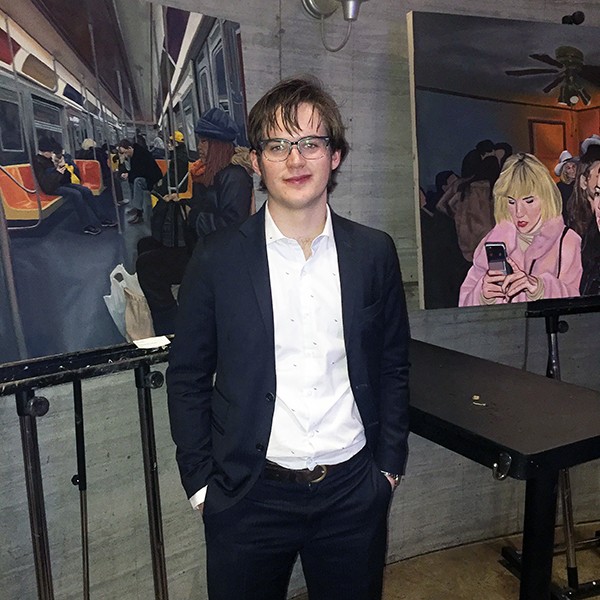Robert Fairchild’s artwork has evolved from the drawings he made at 5 years old.
“I did crayon drawings,” says Fairchild, 21. “Star Wars characters with lightsabers.”
He continued to draw as he got a little older, but, he says, “I was a big nerd, so I drew a lot of dragons and Halo aliens. Like just really the nerdiest subjects I could draw in my sketchbook.”
 Michael Donahue
Michael Donahue
Robert Fairchild
Now his work is “more about the scene and what the figures are doing in that space and occupying that space.”
Fairchild’s work, which is in private collections, has been shown at Crosstown Concourse and other spaces.
His work began changing when he got to high school. “I guess when I started realizing being a nerd wasn’t too cool,” he elaborates. “So, my subjects definitely changed. As I grew up, I started to value things differently. I valued people around me rather than fantasies. I valued reality more than my imagination.”
Fairchild took steps to become a technical artist. “Just by observation and learning skills such as perspective drawing and how to render a subject,” he says. “I wanted to push my limits to that. I’m still trying to do that. It’s an ongoing process.”
He credits his Houston High School art teachers Amanda Schulter and Bobby Spillman with helping him take his art to another level. “They showed me art could be a career and you could turn it into something pretty incredible.”
He made pencil and gouache drawings of family and friends. “I didn’t have a really sophisticated idea,” he says. “I just loved these people, and I wanted to do a drawing of them.”
But making art wasn’t easy, Fairchild says. “It was very difficult. It’s been a long, hard process to get where I am now. This kind of work took a long time. And art never came easy for me. I always had to work at it pretty diligently.”
He knew he was going to major in art when he entered college. “I was fortunate enough to get a full ride to the University of Memphis with their scholastic scholarship. That was an absolute miracle. That’s why I went to college. They have a great program, and I’ve been studying under Beth Edwards and Jed Jackson. And it’s just been great.”
His teachers helped him create art that makes a statement. “There’s nothing wrong with doing a dog portrait, but figuring out why I’m doing a dog portrait. Having some reason and concept behind it.
“I love Edward Hopper. His work is about telling a story with figures and having a meaningful subject. I kind of take from his aesthetic choices and try to put them into my work. Right now, my pieces are about public interaction and private interaction between people. So, it’s about comfort in a social setting.”
Describing his painting Millennial Moment, Fairchild says, “I worked from a photograph from a New Year’s party two years ago. It took me about three months to make, but that was when I started to see how many figures I could have in a scene and how much movement I could get, as well as show this isolation within a very packed environment.”
It wasn’t a strict depiction of the party, he says. “I’ll alter the scene. I’ll change the color palette and paint certain people abstractedly rather than try to render them. The main figure is a girl on her phone. And there are two larger female figures in the forefront of the painting. And you have some wild movement in the background.
“Every figure in the painting is in black or dark, [except] the main girl in front wearing a big pink puffy coat. And she’s on the phone ignoring everyone.
“I knew I wanted to do a party painting and I wanted a lot of figures and [to demonstrate] the fact that [the party] was in my home,” Fairchild says. “And I wanted to show how nasty it was. It was kind of smoky and gritty and dirty. But it was also a really fun time. It was a memorable party.”
His work now is “less about the figure and more about the environment. Now I’m trying to challenge myself with different materials.”
Fairchild still wants to show isolation in his paintings, but his focus has become less about realistically depicting subjects and has shifted to show a subject with “a gestural depiction of a figure. And that they’re alone.”